Report: Low Latency Streaming Media Impacts UX

Today’s consumer has a shorter average attention span than a goldfish. When you also consider the increasing oversaturation of the app market, that means streaming media content providers have to work harder than ever to win customers. In this competitive landscape, one factor most differentiates streaming platforms across industries: offering a high-quality user experience (UX).
The UX of streaming media content is heavily impacted by three metrics:
-
End-to-end latency: The time between video or audio being captured at the source and when it plays back on an end-user’s device.
-
Time to first frame (TTFF): The time it takes for content to initially load on an end-user’s device.
-
Perceived quality: The quality of streaming content, as perceived by an end user—including the video resolution; audio clarity; and performance and stability of the platform.
“If a video doesn’t play immediately, users don’t think of terms like ‘latency’; they think of terms like ‘broken.’ I’ve had bugs reported for delays of less than a second. In today’s instant world, low-latency videos aren’t a feature—they’re an expectation.”
—Brandon Gregory, technical architect at Intouch Solutions
Ready to learn more? Download Wowza 2017 Research Report: Create the Streaming Media Experience Users Want
How Low Does Latency Need to Be?
High latency is a thorny issue for streaming content providers. While there are many latency metrics, end-to-end latency and TTFF tend to have the greatest impact on the UX of streaming media platforms. If either is too high, consumers may abandon the platform altogether.
For example, even delays of an extra 500 milliseconds make gamers two times more likely to navigate away from a gaming platform. And mobile consumers have even less patience: Nearly half say waiting for slow-loading pages is the thing they dislike most about surfing the web on a mobile device.
“High latency can turn a synchronous interaction into an asynchronous one. It’s like the difference between IM and email, or … between Twitter and blogging. To a user, as soon as something doesn’t feel instant, it changes the rules of the game. For starters, there’s less time pressure to for them to respond immediately. And as soon as you introduce gaps, other aspects of the user’s life creep in, and the hot moment can become cold. It gives them time to think about doing something else more enjoyable or productive. This kind of delay can be the enemy of habit creation.
“For an app to earn a place in a user’s life, it has to fit into the time box the user give[s] to it. Maybe they’re taking a micro-break between work tasks or household activities. In a one-minute break, a six-second delay is an eternity.” —Dr. Harry Brignull, independent UX consultant
So, how well are streaming media content providers performing in terms of latency? To find out, Wowza conducted a study of several high-profile platforms across five different industry verticals. We tested each provider’s performance on end-to-end latency and TTFF—and discovered some interesting trends.
Latency Testing: Cumulative Results
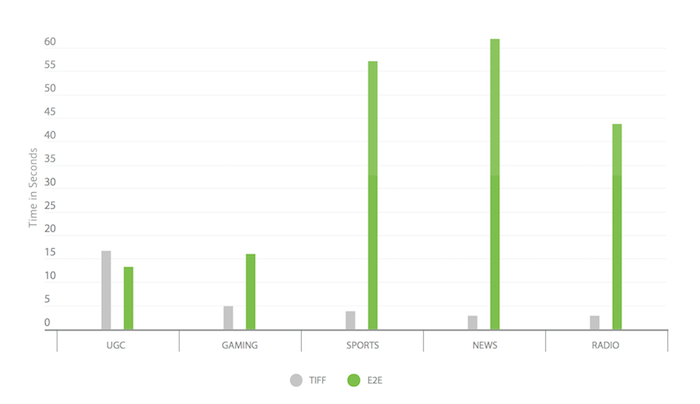
Game Low Latency Is Crucial
Gaming is a $4.3 billion industry, and every second of latency counts. Just two seconds of TTFF delay resulted in transaction abandonment rates of up to 87 percent on Twitch.
Latency Testing: Game-Streaming Services
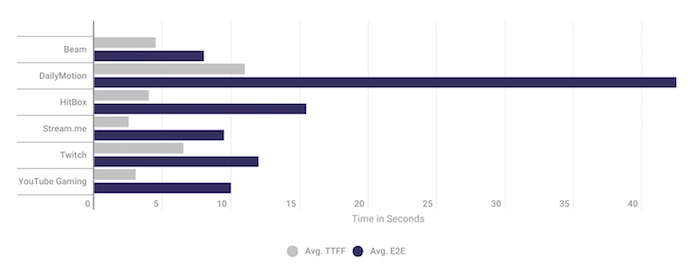
Interactive Content Relies on Low Latency
YouNow has paid over $1 million to broadcasters for live user engagements—which rely on low latency for high performance.
Latency Testing: User-Generated Content Apps

To Avoid Sports Spoilers, You Need Lower Latency
In live-streaming sports, latencies above 30 seconds can cause spoilers—and dissatisfied fans who abandon TV subscriptions.
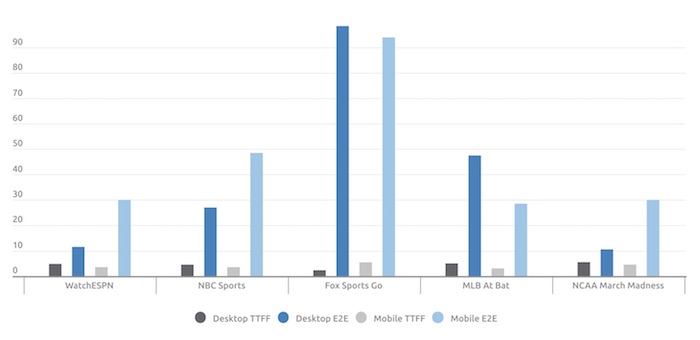
News Flash: Low-Latency Streaming Boosts Trust
For 76 percent of Americans, having the latest news boosts their trust in the source; 63 percent trust news sites and apps that load quickly.
Latency Testing: News Apps (Desktop)
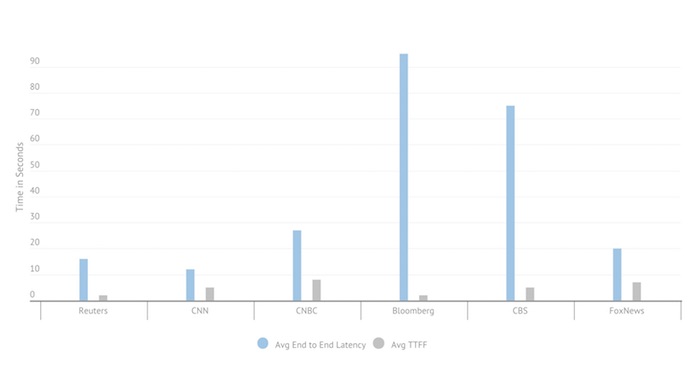
Latency Testing: News Apps (Mobile)
.jpg)
Tune In to Low-Latency Audio
A majority of U.S. adults listen to Internet radio at least monthly—and 95 percent of listening happens on mobile. However, passive listeners still want to dial in for contests or direct-response programs.
Latency Testing: Radio Apps (End-to-End)
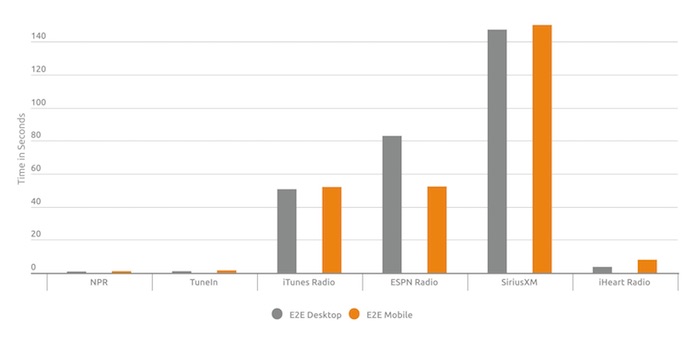
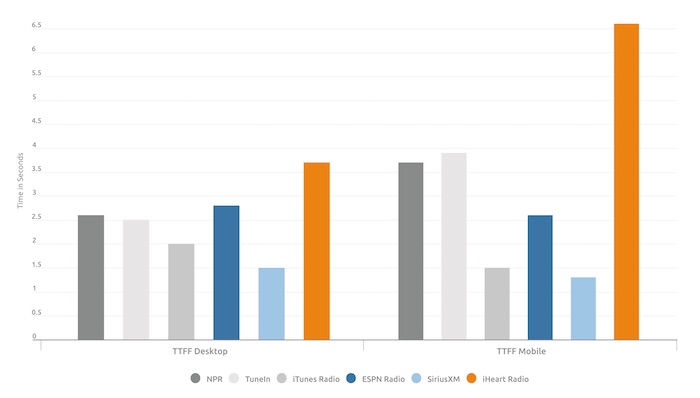
Of course, for many industries and platforms, the UX is about more than just offering the lowest possible latency. For some, high degrees of interactivity, facilitated by low-latency streams, are most important to the UX. For others, streams that compete with the latency of broadcast TV are top priority. For others still, perceived quality and/or delivery at scale matter more than ultra-low latency.
“When thinking about how video latency drives user experience, what comes to mind is typically ‘make sure it’s fast. Faster equals better experience.’ However, we should be more thorough than that. Instead, as designers, we should ask: ‘How well is the user’s expectation met with this video at all, before we consider speed? Does video even serve the overall UX purpose and vision, or would another type of content be better?’” —Aimee Gonzalez, lead consultant at Aimee Gonzalez Web Consulting
Now that the power in buying relationships has shifted from the provider to the consumer, providers that offer the best UX for their audience will have a competitive advantage. Read our comprehensive research report to learn more about:
-
Trends in the streaming media market and how content is consumed.
-
What contributes to a great live-streaming UX across various markets.
-
Which platforms have the lowest and highest latency scores.
-
How leading platforms could provide a better experience for end-users.
“No one likes dealing with latency, but you’d be surprised at how forgiving users can be when they are given transparency into what’s going on. So if the system is running slowly, or it needs to take some time to buffer, don’t just let the interface hang. Instead, present them with an explanation and an estimate on how long the delay will take. You could even get creative and offer them an ‘easter-egg’ game to play while they wait!” —Meg Dickey-Kurdziolek, freelance UX researcher and designer
Learn more about incorporating live streaming into your platform with the Wowza product portfolio.
FREE TRIAL
Live stream and Video On Demand for the web, apps, and onto any device. Get started in minutes.
- Stream with WebRTC, HLS and MPEG-DASH
- Fully customizable with REST and Java APIs
- Integrate and embed into your apps




